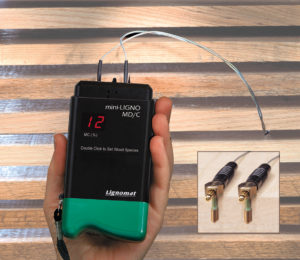During lumber drying process, whether air dry or kiln dry, a moisture meter is the most reliable means of determining moisture content. However, it can be difficult to get it right. Being able to correctly measure moisture content of stacked lumber being dried is crucial for optimized lumber quality. How can you measure the shell and core moisture content of lumber boards while they are stacked in the yard or inside the kiln? How can you choose the best moisture meter for in-kiln moisture monitoring since nobody should enter a hot dry kiln?
While we all know that there may be higher moisture exist, and that the core moisture content can be different in the drying process, it can be tricky to reach many locations in the stack with a handheld meter or electrode. Then a robust and accurate moisture meter with connection to extension cables and probes come to play. It will make your lumber drying work easier and more confident. Lignomat package M-11 is such a moisture meter tool kit that is ideal for stacked lumber moisture measurement. It includes mini-Ligno MD/C, PKB probes and PK-mini cables. It can be used to monitor lumber drying – for stacked lumber in the air-drying yard or inside all sizes and types of dry kiln – from solar to conventional steam kilns.
However, not any moisture meter equipped with cables and probes help you succeed in moisture monitoring. There are some key features that you will need to consider in order to get reliable readings from your stacked lumber. Besides, distribution of probes throughout the stack and measuring depth are also essential to ensure accurate measurements. Identifying sample boards at the start is important to determine the moisture loss rate. Take important factors such as air flow and varied drying rate across the stack into consideration while locating the probes, and avoid placing them across changing grain, knots, etc. It is suggested that at least 1/3 of the lumber thickness has to be penetrated to measure the core moisture.
Choosing the Best Moisture Meter for Your Stacked Lumber
When selecting a wood moisture meter for your stacked lumber, it’s important to consider the following:
- Moisture Meter’s accuracy
It is extremely important for your moisture meter to deliver consistently accurate measurements. - Moisture meter’s calibration capabilities
Automatic calibration checks before each measurement guarantees accurate readings. - Moisture meter’s species correction
Species correction is necessary to make sure the meter is calibrated for your lumber species. - Moisture meter’s temperature correction capabilities
Temperature correction improve accuracy when testing moisture in extreme temperature outdoor or inside a heated kiln. - Measuring range
It should cover the critical range below fiber saturation point to monitor lumber drying. - Insulated cables
The Teflon-cable can withstand hot and humid conditions in a dry kiln. - Insulated probes
The shanks of probes should Teflon-coated to ensure that the moisture is measured at the core and measurements are not affected by surface moisture.
→ Click for more info about moisture meter for in-kiln moisture measurement.
→ Click to read more about How to Air-Dry Lumber: Turn Freshly Cut Stock into A Cash Crop of Woodworking Woods by Dave Boyt, Woodcraft Magazine


